
Concept explainers
(a)
Interpretation:
A steroid is to be classified as saponifiable or nonsaponifiable lipid.
Concept introduction:
Lipids are one of those macromolecular substances that are present in the living cell. The cell membrane of the living cell is made up of lipids. The lipids have a greasy, waxy and oily texture. The lipids are insoluble in water. They include natural oils, waxes, and steroids.
Answer to Problem 18.4E
A steroid is a nonsaponifiable lipid.
Explanation of Solution
A hydrolysis reaction carried out in a basic solution is known as saponification reaction. The term saponifiable lipids indicate the lipids that can undergo saponification reaction. The lipids that have ester group are saponifiable lipids. The basic structure of steroid is composed of three six-member ring and one five-member ring. The steroid ring system is shown below.
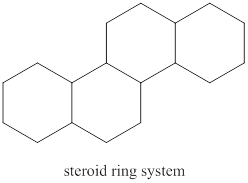
Figure 1
The basic structure of steroid does not have any ester group. Therefore, a steroid is a nonsaponifiable lipid.
A steroid is a nonsaponifiable lipid.
(b)
Interpretation:
Wax is to be classified as saponifiable or nonsaponifiable lipid.
Concept introduction:
Lipids are one of those macromolecular substances that are present in the living cell. The cell membrane of the living cell is made up of lipids. The lipids have a greasy, waxy and oily texture. The lipids are insoluble in water. They include natural oils, waxes, and steroids.
Answer to Problem 18.4E
Wax is a saponifiable lipid.
Explanation of Solution
A hydrolysis reaction carried out in a basic solution is known as saponification reaction. The term saponifiable lipids indicate the lipids that can undergo saponification reaction. The lipids that have ester group are saponifiable lipids. The wax is an ester of long-chain alcohol and a fatty acid. The structure of a simple wax that is beeswax is shown below.
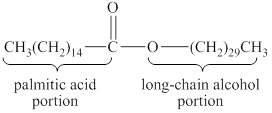
Figure 2
The basic structure of wax has an ester group. Therefore, wax is a saponifiable lipid.
Wax is a saponifiable lipid.
(c)
Interpretation:
A triglyceride is to be classified as saponifiable or nonsaponifiable lipid.
Concept introduction:
Lipids are one of those macromolecular substances that are present in the living cell. The cell membrane of the living cell is made up of lipids. The lipids have a greasy, waxy and oily texture. The lipids are insoluble in water. They include natural oils, waxes, and steroids.
Answer to Problem 18.4E
A triglyceride is a saponifiable lipid.
Explanation of Solution
A hydrolysis reaction carried out in a basic solution is known as saponification reaction. The term saponifiable lipids indicate the lipids that can undergo saponification reaction. The lipids that have ester group are saponifiable lipids. The triglyceride is formed from glycerol and three fatty acids with ester bonds. The general structure of triglyceride is shown below.
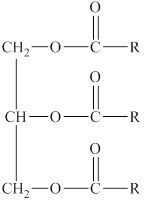
Figure 3
The basic structure of triglyceride has ester groups. Therefore, a triglyceride is a saponifiable lipid.
A triglyceride is a saponifiable lipid.
(d)
Interpretation:
A phosphoglyceride is to be classified as saponifiable or nonsaponifiable lipids.
Concept introduction:
Lipids are one of those macromolecular substances that are present in the living cell. The cell membrane of the living cell is made up of lipids. The lipids have a greasy, waxy and oily texture. The lipids are insoluble in water. They include natural oils, waxes, and steroids.
Answer to Problem 18.4E
A phosphoglyceride is a saponifiable lipid.
Explanation of Solution
A hydrolysis reaction carried out in a basic solution is known as saponification reaction. The term saponifiable lipids indicate the lipids that can undergo saponification reaction. The lipids that have ester group are saponifiable lipids. The structure of phosphoglyceride is similar to that of a triglyceride. The only difference between triglyceride and phosphoglyceride is that on the third carbon of glycerol, a phosphate group is attached in the phosphoglyceride. The general structure of phosphoglyceride is shown below.
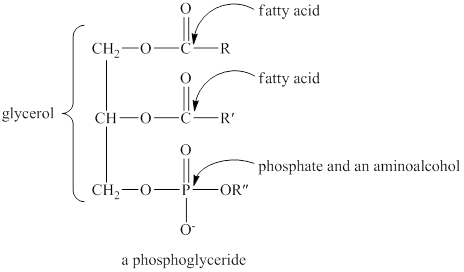
Figure 4
The basic structure of phosphoglyceride has ester groups. Therefore, a phosphoglyceride is a saponifiable lipid.
A phosphoglyceride is a nonsaponifiable lipid.
(e)
Interpretation:
A glycolipid is to be classified as saponifiable or nonsaponifiable lipid.
Concept introduction:
Lipids are one of those macromolecular substances that are present in the living cell. The cell membrane of the living cell is made up of lipids. The lipids have a greasy, waxy and oily texture. The lipids are insoluble in water. They include natural oils, waxes, and steroids.
Answer to Problem 18.4E
A glycolipid is a saponifiable lipid.
Explanation of Solution
A hydrolysis reaction carried out in a basic solution is known as saponification reaction. The term saponifiable lipids indicate the lipids that can undergo saponification reaction. The lipids that have ester group are saponifiable lipids. The glycolipid contains carbohydrate in it. The glycolipids are also termed as cerebroside as they are present in the brain. The typical structure of glycolipid (cerebroside) is shown below.
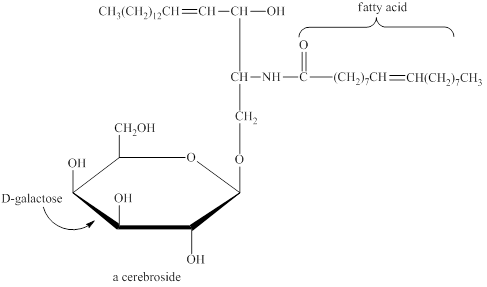
Figure 5
The basic structure of glycolipid does not have an ester group but they have an amide group that can undergo saponification. Therefore, a glycolipid is a saponifiable lipid.
A glycolipid is a saponifiable lipid.
(f)
Interpretation:
A prostaglandin is to be classified as saponifiable or nonsaponifiable lipid.
Concept introduction:
Lipids are one of those macromolecular substances that are present in the living cell. The cell membrane of the living cell is made up of lipids. The lipids have a greasy, waxy and oily texture. The lipids are insoluble in water. They include natural oils, waxes, and steroids.
Answer to Problem 18.4E
Prostaglandin is a nonsaponifiable lipid.
Explanation of Solution
A hydrolysis reaction carried out in a basic solution is known as saponification reaction. The term saponifiable lipids indicate the lipids that can undergo saponification reaction. The lipids that have ester group are saponifiable lipids. The basic structure prostaglandin is composed of a five-member ring with two substituted carbon chain. The structure of prostaglandin
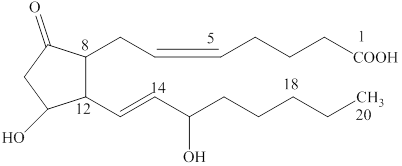
Figure 6
The basic structure of prostaglandin does not have an ester group. Therefore, a prostaglandin is a nonsaponifiable lipid.
Prostaglandin is a nonsaponifiable lipid.
Want to see more full solutions like this?
Chapter 18 Solutions
Chemistry for Today: General, Organic, and Biochemistry
 Chemistry for Today: General, Organic, and Bioche...ChemistryISBN:9781305960060Author:Spencer L. Seager, Michael R. Slabaugh, Maren S. HansenPublisher:Cengage Learning
Chemistry for Today: General, Organic, and Bioche...ChemistryISBN:9781305960060Author:Spencer L. Seager, Michael R. Slabaugh, Maren S. HansenPublisher:Cengage Learning Chemistry: Principles and ReactionsChemistryISBN:9781305079373Author:William L. Masterton, Cecile N. HurleyPublisher:Cengage Learning
Chemistry: Principles and ReactionsChemistryISBN:9781305079373Author:William L. Masterton, Cecile N. HurleyPublisher:Cengage Learning
 Introductory Chemistry: A FoundationChemistryISBN:9781337399425Author:Steven S. Zumdahl, Donald J. DeCostePublisher:Cengage Learning
Introductory Chemistry: A FoundationChemistryISBN:9781337399425Author:Steven S. Zumdahl, Donald J. DeCostePublisher:Cengage Learning Organic And Biological ChemistryChemistryISBN:9781305081079Author:STOKER, H. Stephen (howard Stephen)Publisher:Cengage Learning,
Organic And Biological ChemistryChemistryISBN:9781305081079Author:STOKER, H. Stephen (howard Stephen)Publisher:Cengage Learning, General, Organic, and Biological ChemistryChemistryISBN:9781285853918Author:H. Stephen StokerPublisher:Cengage Learning
General, Organic, and Biological ChemistryChemistryISBN:9781285853918Author:H. Stephen StokerPublisher:Cengage Learning





